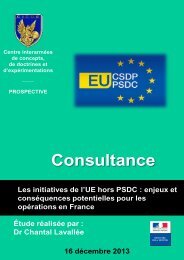Conference
science-research-bulletin-2013-conference
science-research-bulletin-2013-conference
Create successful ePaper yourself
Turn your PDF publications into a flip-book with our unique Google optimized e-Paper software.
EUROPEAN POLICE SCIENCE AND RESEARCH BULLETIN<br />
SPECIAL CONFERENCE EDITION<br />
accounts on Twitter have 1 400 000 followers,<br />
and on the more recent Google + platform,<br />
Police accounts have 3 300 followers. (Norfolk<br />
Police, 2013). On Twitter, there are numerous<br />
of official police Twitter accounts for a range<br />
of police officers from the most senior level to<br />
the neighbourhood beat officer; there are now<br />
over 2 000 of these accounts (Keane, 2013). This<br />
essay will examine the factors that drove that<br />
widespread level of adoption and will discuss<br />
the policy issues, which have been addressed or<br />
remain to be addressed.<br />
The past few years has seen the growth of<br />
Internet usage, the exponential rise of mobile<br />
communications technology and a widespread<br />
adoption of social media sites. In 2013, the<br />
European Commission reported that, across<br />
the European Union 40 % of the population<br />
post messages on social media sites and instant<br />
messaging (in the UK this is 57 %) (Eurostat,<br />
2013). In addition, the use of social media is<br />
growing; in May 2011 it was reported that the<br />
micro-blogging site, twitter.com had 200 million<br />
registered accounts worldwide and was growing<br />
by 460 000 every day (BBC, 2011). In the same<br />
month, Sheryl Sandberg, Chief Operating Officer<br />
for Facebook stated that their site had over 500<br />
million active users, 30 millions of whom were<br />
from the United Kingdom (Sandberg, 2011).<br />
These figures too are set to increase with a recent<br />
report stating that just under 1 million people<br />
now join the site everyday (Observer, 2011).<br />
Central to understanding how UK policing has<br />
adopted social media platforms for community<br />
engagement has been increased importance<br />
in relation to the police commitment to<br />
neighbourhood policing (ACPO, 2006).<br />
The national initiative for the roll out of<br />
neighbourhood policing had its antecedents in<br />
the National Reassurance Policing Programme<br />
which trialled to address the gap between the<br />
public perception of crime in their locality (which<br />
they saw as high) together with the trends in the<br />
rates of local crime (which were dropping) (Tuffin<br />
et al. 2006). Guidance published emphasised the<br />
importance that the police service should meet<br />
the expectations of their communities of:<br />
• ‘Access, to the police through a named<br />
contact,<br />
• Influence over the community safety priorities<br />
for the area,<br />
• Interventions to solve problems and<br />
• Answers to include feedback on results’<br />
(ACPO, 2006: 4).<br />
The programme was seen to be achieving success<br />
and in 2009 the British Crime Survey reported<br />
falls in many areas of reported crime and in the<br />
fear of crime and increases in the confidence in<br />
the police. (Home Office, 2010).<br />
It was against the background of these changes<br />
that the police began to adopt social media to<br />
explore its potential as a means of engaging,<br />
communicating and tackling crime. In 2008 a<br />
neighbourhood policing officer P.C. Ed Rogerson<br />
of North Yorkshire Police was identified as<br />
an early adopter of social media use, using a<br />
combination of YouTube footage and a Facebook<br />
group to highlight the issue of graffiti on his beat<br />
in Harrogate, leading to the arrest of an offender.<br />
(CRP News, 2008). It was the identification of<br />
the work of P.C. Rogerson and other early police<br />
adopters, which led to, the following year, a<br />
UK Policing <strong>Conference</strong> on social media, being<br />
held in October 2009. As a direct result of the<br />
conference, two policy areas were identified and<br />
addressed; the need for senior officer support<br />
and leadership and the need for guidance for<br />
police officers and forces. The former issue<br />
was addressed with the appointment of (then)<br />
Assistant Chief Constable Gordon Scobbie as<br />
ACPO lead for Digital Engagement and the latter<br />
was addressed by the publication, the following<br />
March, of the first national guidance for the Police<br />
Service in using social media. Engage: Digital and<br />
Social Media Engagement (ACPO, 2010) was a<br />
joint publication between the Association of<br />
Police Officers (ACPO) and the National Policing<br />
Improvement Agency (NPIA). It provided police<br />
forces with examples of use from early adopters,<br />
guidance on using Twitter and a set of principles<br />
for engagement, stating the need to be ‘credible,<br />
consistent, responsive, an ambassador, inclusive,<br />
ethical and personable.’ (ACPO, 2010: 7-8). This<br />
guidance was widely circulated with UK forces<br />
and is still available in 2014.<br />
Later in 2010, saw a UK Police Force demonstrate<br />
how they were taking social media seriously.<br />
On 14th and 15th October Greater Manchester<br />
Police (GMP) used Twitter to publish information<br />
about every incident they dealt with in a 24<br />
hour period. Using the Twitter hashtag #GMP24,<br />
GMP tweeted details of the 3 025 incidents<br />
they dealt with. The Chief Constable, Peter<br />
102





